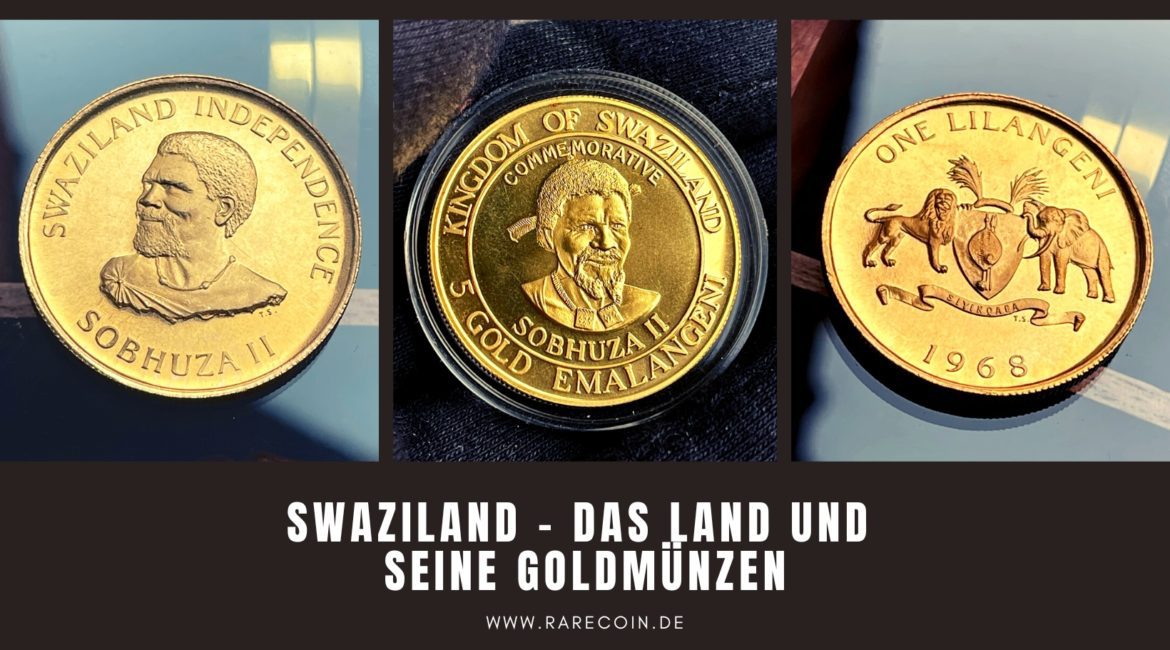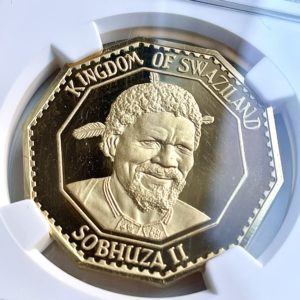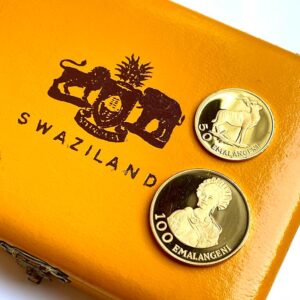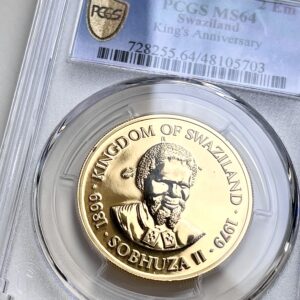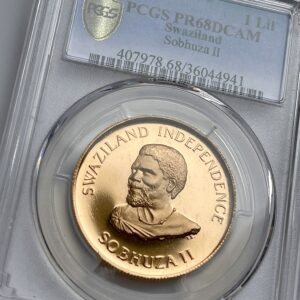Swaziland, officially known as the Kingdom of Eswatini, is a small landlocked country in southern Africa. Here are some interesting facts about Swaziland and its collectible gold coins:
Name and independence: Swaziland was named after the Swazi people, who form the largest ethnic group in the country. The country gained its independence from the United Kingdom in 1968. In April 2018, the official name of the country was changed from Kingdom of Swaziland to Kingdom of Eswatini, which is also the common name in Swaziland.
Monarchy and government: Swaziland is an absolute monarchy, with King Mswati III as head of state. The king has supreme power and authority over the country’s government, although there is also a parliament and a judiciary.
Size and geography: Swaziland is one of the smallest countries in Africa, with an area of 17,364 square kilometers. It borders South Africa to the west and Mozambique to the east. The country has a varied landscape that includes mountains, savannahs and rainforests. Eswatini ( Swaziland) population at the beginning of 2023: 1.193 million people.
Culture and Traditions: Swaziland is known for its rich cultural heritage, which is celebrated with various traditional ceremonies and festivals. The Umhlanga or reed dance ceremony is one of the most popular events in the country. It is an annual festival where young girls dance and sing before the king, carrying reeds to reinforce the palace.
Wildlife and Conservation: Swaziland is home to a variety of wildlife including elephants, lions, hippos and rhinos. The country is also home to several game reserves and national parks, including Mlilwane Wildlife Sanctuary, Hlane Royal National Park and Mkhaya Game Reserve. Efforts have been made to protect and preserve the country’s natural resources.
Language and religion: Swaziland has two official languages: Swazi and English. Christianity is the predominant religion, although traditional beliefs and practices still play an important role in the country’s culture and traditions.
Education and literacy: Swaziland has a high literacy rate of about 88 %. School attendance is free and compulsory for children between the ages of 6 and 13. The country has several universities and colleges, including the University of Eswatini.
Economy and industry: Swaziland’s economy is largely based on agriculture, with sugar cane being the most important crop. The country is also known for its textile, forestry and mining industries. Swaziland is rich in natural resources, including coal, diamonds and gold.
Tourism and Attractions: Swaziland is a popular tourist destination and offers a unique blend of culture, wildlife and natural beauty. Among the most popular tourist attractions are Mantenga Cultural Village, Ezulwini Valley and Sibebe Rock, the second largest exposed granite dome in the world.
Who was King Sobhuza II:
King Sobhuza II was King of Swaziland from 1921 until his death in 1982, making him the longest reigning monarch in African history. Sobhuza was born on July 22, 1899, in Zombodze, Swaziland, the son of King Ngwane V. After the death of his father in 1921, he became king at the age of four months. During his long reign, Sobhuza II witnessed the transformation of Swaziland from a British protectorate to an independent kingdom in 1968. His reign was marked by a strong commitment to preserving traditional Swazi culture and promoting the economic development of his people.
One of Sobhuza’s most significant achievements was his ability to preserve the unity of the Swazi people during a time of great change. Sobhuza also played an important role in the struggle for African independence in the mid-20th century. He was a founding member of the Pan-African Congress, an organization that advocated for the rights of African people and sought to end colonialism on the continent. Sobhuza’s leadership and advocacy for African unity helped inspire the independence movements of many other African countries.
In addition to his political achievements, Sobhuza was also a strong advocate for education and health care. He established several schools and clinics throughout Swaziland, enabling many Swazis who otherwise would not have had access to education and health care.
Sobhuza II’s reign ended on August 21, 1982, when he died at the age of 83. He was succeeded by his son Mswati III, who is still king of Swaziland today.
Typical food in Swaziland:
Pap: This is a staple food in Swaziland made from ground maize flour. It is cooked with water to produce a thick, porridge-like consistency and is often eaten with meat or vegetables. It resembles the South African dish pap and is sometimes called phutu pap in Swaziland.
Braaivleis: Braaivleis is the Afrikaans term for barbecue and is a popular cooking method in Swaziland. Meat, such as beef, chicken or lamb, is often marinated in spices and grilled over an open flame. It is usually served with porridge and chakalaka, a spicy seasoning mixture of vegetables and spices.
Umncweba: This is a traditional Swazi dish prepared from dried, salted meat, usually from pork. The meat is soaked in water to rehydrate it and then cooked over an open flame. It is often served with vegetables or porridge and is a popular dish at feasts and special occasions.
Sishwala: Sishwala is a traditional Swazi dish prepared from ground peanuts. The peanuts are roasted and ground to a fine powder, which is then mixed with water and boiled until it takes on a thick, creamy consistency. It is often eaten with meat or vegetables and is a popular dish among the Swazi people.
Mageu: Mageu is a popular fermented drink made from corn flour. The cornmeal is mixed with water and fermented for several days, resulting in a thick, sour drink. It is often served as a refreshing drink on hot days and sometimes mixed with milk or sugar to sweeten it.
Incwancwa: This is a traditional Swazi snack made from roasted and ground corn kernels. It is often eaten as a snack or added to dishes as a crunchy topping. Sometimes it is mixed with sugar or salt to improve the taste.
Siphuphe setindlubu: This is a Swazi dessert made from pumpkin. The pumpkin is cooked until soft and then pureed with sugar and spices such as cinnamon and nutmeg. It is often served with cream or custard and is a popular dessert in the fall season.
Swaziland and its gold coins
Swaziland, officially known as the Kingdom of Eswatini, has a rich cultural heritage, and its currency is the Swazi Lilangeni. Swaziland has also issued several gold collector coins over the years, which have become very popular with numismatists and collectors.
One of the most remarkable gold collector coins of Swaziland is Swaziland – 5 Emalangeni- 1978 – Sobhuza II – 25th Jubilee Queen Elizabeth II. We are proud to offer you this unique and historic commemorative silver jubilee edition of Elizabeth II. Issued in 1978 by Eswatini (“Swaziland”), this coin is a true masterpiece and a must for any collector or investor. This Elizabeth II Silver Jubilee Commemorative Edition is a rare and valuable piece that will impress any collector or investor worldwide. Their exquisite design and high quality material make them a piece of history that you will definitely enjoy.
Another popular gold collector coin from Swaziland is the Swaziland 1974 20 Emalangeni Sobhuza II. This gold coin was minted on the occasion of the 75th birthday of the king. What makes this gold coin special is that it has been certified by NGC with a PF66 UCAM (Ultra Cameo) – only 4 coins have ever been graded higher by NGC.
Gold collector coins from Swaziland are usually available in limited mintage. They are often sought by collectors interested in African coins or coins with iconic landmarks and symbols. The value of these coins can vary depending on their rarity, condition and demand among collectors. Call us if you are interested in gold coins from Swaziland and we will be happy to answer your questions.
Gold collector coins from Swaziland are a fascinating part of the country’s numismatic history. These coins feature intricate designs and symbols that represent the culture and heritage of Swaziland, and they are highly sought after by collectors around the world. Whether you are a numismatist or a collector of African coins, gold coins from Swaziland are a unique and valuable addition to any collection.
Discover our interesting gold coins from Swaziland here:
-
Swaziland/Eswatini – 1974 – 20 Emalangeni – Sobhuza II – NGC PF66 Ultra Cameo
2.595,00 €2.495,00 €plus shippingDelivery Time: approx. 2-3 days (excluding Saturdays, Sundays and public holidays) -
Swaziland 1975 Sovereign Set – 50 and 100 Emalangeni – 12.95g Gold Proof
1.400,00 €plus shippingDelivery Time: approx. 2-3 days (excluding Saturdays, Sundays and public holidays) -
Swaziland – Eswatini – 1979 – 2 Emalangeni – Sobhuza II – 80th birthday – 1oz gold – PCGS MS64
2.950,00 €plus shippingDelivery Time: approx. 2-3 days (excluding Saturdays, Sundays and public holidays) -
Swaziland – 1968 – 1 Lilangeni – Sobhuza II – Independence Issue – 1oz Gold Proof – PCGS PR68 DCAM
3.950,00 €plus shippingDelivery Time: approx. 2-3 days (excluding Saturdays, Sundays and public holidays)

